
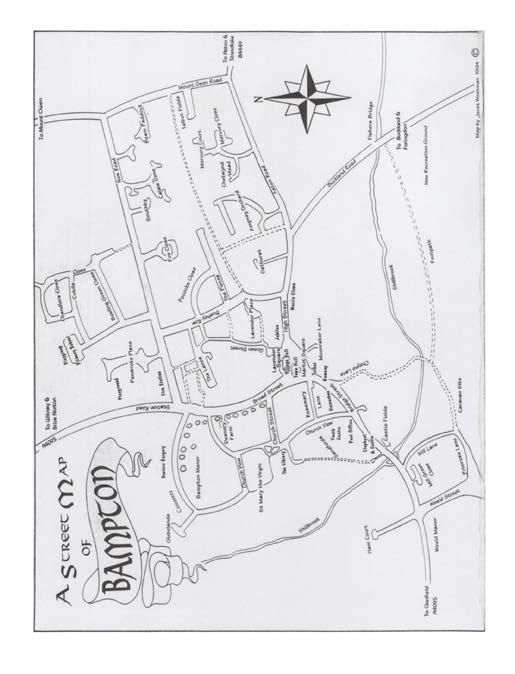
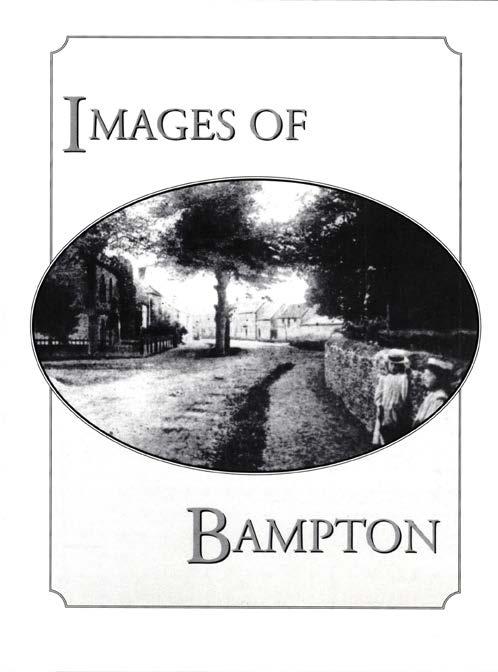
40
Published by Bampton Parish Council
First published 1996
© Text:John Parrish and Janet Newman, 1996
British Library Cataloguing in Publication Data. A catalogue record for this book is available from the British Library.
The Images of Bampton book has been re-artworked and reprinted April 2024. The text, however, remains as first published, with references to 1996 and beyond.
ISBN O 9529562 0 9
Photographs collected by Janet Newman and reproduced by Roy Barratt
Text and captions by John Parrish
Edited by Annabel Jones
Design, origination and printing in Great Britain by York Publishing Services Ltd
Contents Foreword V Bampton Parish Council Chairmen vi 1 Introduction 2 The Town Hall 4 3 The Church 9 4 Aspects 12 5 The Horse Fair 29 6 O.O.Collett’s Car 35 7 The First World War 1914 -18 39 8 The ‘Morris’ 41 9 ‘In comes I’ 47 10 The Great Shirt Race 49 11 Events 52 12 The Railway Station 61 13 The Fire Brigade 64 14 Schools 70 15 People 79 Acknowledgements 89
Foreword
Bampton has a unique ambience - both for those who were born here or have lived here for many years, and also to those who are newcomers. Outsiders recognise it- residents just know it.
A visual history of Bampton gives us a sense of identity. To see how people have lived in our village over the past 100 years is both interesting and rewarding. Images of Bampton is a valuable collection of photographs showing not only the past life of our community but providing continuity with our lives today.
We know the changes that have taken place; these photographs make us realise how much of our local character must be preserved for future generations.
Our thanks are due to all the residents who have helped produce this really fine record. The Parish Council is delighted to lend its support.
.Jim Taylor Chairman, Bampton Parish Council
v
Bampton Parish Council Chairmen
1894 Admiral F.R. Blackburne
1901 Theo Carter
1902 Rev. W. H. Hampshire
1904 F.D.Hunt 1919 R.T.Rose
1926 Rev. Preb. L.W. Gegg
1936 Lt.Col. A.M.Colvile DSO
1937 D.L. Hall
1940 E.W.Fry
1950 B. Rose
1951 E.W.Fry
1952 Lt. Col. J J. Powell
1955 Mrs. L.M. Hampton
1955 Miss M.A. Pollard OBE
1958 H.E. Pocock
1965 D.P Hirons
1967 M.E..J. Clack
1971 R.L.G. Carter
1972 J.L. Hughes-Owens
1978 P.R. Matthews
1981 Mrs R.E.Colvile
1984 . J.A. Quick
1984 A.E..J.C. Woodley
1986 Mrs.J.E. Allinson
1994 T.J. Taylor
1 Introduction
‘The King Holds Bentone ... ‘
Thus begins the entry about Bampton in Domesday Book of 1086.
There follows a detailed description (expressed in the language of the time) from which it is apparent that Bampton was a place of no mean importance. Indeed it was the only place in the county apart from Oxford to be recorded as a ‘market town’.
The first definitive reference to our community occurs in about 956 when King Eadwig (or Edwy) was on the throne. In the reign of William 1 a Charter to Exeter Cathedral of 1069 refers to a gift from the Saxon king between 955 and 957 to a ‘Holy Man’ at Bemtun, which has since been positively identified as Bampton. Over the years there have been several different spellings of Bampton but the first reference to Bampton in the Bush does not occur until the seventeenth century, the title being attributed Lo our relative isolation from other towns or hamlets in the area. Lloyd Hughes-Owens in his splendid local historical work The Bampton We Have Lost believes that we were not as remote as the reference to ‘Bush’ would suggest but there is a further reference in Dr. Robert Plot’s Natural History of Oxfordshire, in 1677 when he wrote, ‘there was no stoned road ... from Bampton to the neighbouring towns and villages and travellers were in the habit of striking across the common and finding their way in the best way they could ... ‘ In geographical terms at least, it was (and to a certain extent still is) remote from the main routes leading to Witney, Faringdon and Burford.
There is however sufficient evidence to assume that ‘Bampton’ has developed from the Saxon words ‘Beam’ (a tree or cross) and ‘tun’ (a town) and the photograph on page 2 is of a house known as ‘The Beam’ - now sandwiched (and effectively submerged) by Talbot Fields and Beam Paddock. From the house a remaining footpath runs to Broad Street with only one or two breaks and diversions at Bushey Row and Queen Street. This path used to be called the ‘burial footpath’ along which coffins were brought from Aston to Bampton. Although the present ‘Beam’ is of eighteenth-century construction, in 1985 an early twelfth-century column-base was taken from one of its walls during building work. Dr. John Blair of The Queen’s College, Oxford believes that this site was that of a chapel known as St Andrew’s ‘Chapel of Beme’ mentioned in a fourteenth-century survey. (It may be noted that St Andrew is represented by one of the four stone figures at the base of St Mary’s church spire.) Dr. Blair also concurs with the view that it is this same ‘beam’ which gives Bampton its name and that the chapel, erected on an early Roman site, was an early religious centre which survived into the Anglo-Saxon period later to be superseded by the Church of St. Mary. The ‘beam’ may have been a timber cross, or possibly even a pre-Christian ritual feature. In the 1880s the remains or thirteen burials were found near to this site and in 1959 a quantity or Iron Age and Roman pottery and coins was discovered in the same vicinity.
vi 1

So much for the ‘name’ and the early history. During the centuries which followed, the fortunes of Bampton relied upon agriculture and the growth of a thriving leather industry. Possible traces of old tan pits have been identifed in the garden of Box House in the Market Square and during the seventeenth and eighteenth centruies in particular the town was famed for its glove-making, gaiter and sheepskin products. By the end of the eighteenth century these activities began to falter and combined with the steady changes in farming practices (‘one man and a binder could cut as many acres in a day as twelve men with sickles’) the population of Bampton plummeted from a figure of 1700 in I861 to 1167 in 1901. In spite of the new railway built in 1873 (see page 61), Bampton had by then become a ‘village’, a description not entirely disliked by the large number of newcomers who began to ‘infiltrate’ the community. Indigenous residents - an ever dwindling proportion - still called Bampton a ‘town’ and some of the photographs in this book illustrate the number of family businesses and shops which have thrived in Bampton, one or two of which we still have today.
Until the end of the nineteenth century, the civil and religious functions of our rural community were in the hands of the Vestry. Largely controlled by the Church, Vestry members also included those who were of some local standing, for example, the Lord of the Manor, the squire, schoolmaster and so on, but in 1894 the then Liberal government under Mr. Gladstone passed the Local Government Act which established a new structure, one which still remains in existence i.e. Parish Council/District Council/County Council. The Parish Council of Bampton. democratically elected, consisted of eleven members, as it does today, ancl under the chairmanship of Admiral Blackburne sat for the first time on 4th December 1894. This book of old photographs is, although a little late, intended to mark the centenary of that meeting.
Now in the 1990s we have gone full circle - the population is in the region of 2500 or a little more following the building of over 100 new homes in the 1950s and a further 350 since that date! The majority of our residents now work elsewhere, making extensive use or the motor car but finding Bampton a ‘special’ and very desirable place in which to live. Happily, perhaps, we do not share an influx of tourist coaches which beseige other ‘B’ towns in the Cotswold area: for example Barnsley, Bibury, Bourton, Broadway, Burford - long may it remain so!
2 3
The Beam
2 The Town Hall
In 1241 the right to hold a market in Bampton was granted by the King, a jealously guarded prerogative of the monarch - and this added kudos and much importance to the community. By the middle of the eighteenth century however the weekly Wednesday market had virtually ceased to function. While there were strong efforts made to revitalise it in 1766, these were only partially successful and it has been suggested that the ‘open’ Market Square, exposed to the elements, was a major deterrent. Such was the position in the 1830s, when the Vestry decided to ask an architect to draw up plans for a Town Hall/Market House with the dual purpose of providing shelter for stall holders with a room for meetings on an upper floor. George Wilkinson of Witney was approached and his proposals showed that the cost of construction would be £300! (George Wilkinson was the elder brother of the better known William Wilkinson whose designs were used for the Randolph Hotel in Oxford, St Edward’s School, the Warneford Hospital, Lew Church and numerous secular buildings throughout the county.)
In August 1838 the foundation stone or the Town Hall was laid and within a few months the building was finished and apart from the in-filling of the arches at the turn of the century, looked much as it does today. The nineteenth-century market however, in spite of being under cover, continued to decline and within a few years it had again ceased to operate. The remaining open areas at ground floor level began to be used by local ‘layabouts’ and many thought that although the upper room was proving useful for local meetings and events, the building, (whose architecture was not to everyone’s taste) was probably a ‘white elephant’. Part of the ground floor area became the headquarters of the Bampton Fire Brigade and another room became available for ‘reading purposes’. Sadly, the building was allowed to deteriorate and in 1970 there were some who suggested demolition, but after public meetings in November 1971 it was nevertheless decided to renovate at an estimated cost of £6000 (another £2000 necessary to repair the clock failed to obtain Parish Council support).
The principal sum was borrowed from the Public Works Loan Board while John Taylor, the then proprietor of the Market Square Garage, made an offer of £5 (!) for the clock. This was accepted and he - making some of the parts himself-carried out the necessary repairs, installing the clock on the garage fascia boards, where it still remains.
The restored Town Hall was opened in August 1972 by Freda Davey of The Elms, daughter of Fred K. Staples-Brown, a well-known resident and much respected Bamptonian at the beginning of the century. To help cover the costs of repayment and the interest on the borrowed sum, the Parish Council entered into a lease with the Alvescot College for the upper level while one of the ground floor rooms became a new Council Chamber. There was also space for a small room for public meetings, (the Fire Brigade having moved to the new Fire Station in 1971).
Although there were some objectors to the lease arrangement (suggesting that Bampton should have exclusive use of the whole building) financial considerations outweighed all else and the College occupied the first floor room until 1973, later being leased to the newly formed West Oxfordshire Arts Association.
In keeping however with Bampton ‘s inclination (and almost ‘custom’) to duplicate and even triplicate many of its activities (Spajers/ Pumpkin Club; Conservation Groups Bampton Environmental Watch Group/Society for the Preservation of Bampton; W.1./ Ladies Club/ Mothers Union; three teams of Morris Dancers and so on) we now have a Town Hall and a Village Hall so that our options may be kept well and truly open!

4 5
Set at an oddly high level (and in an unsuitably sized niche) this ‘First Stone’ is seen in the north wall of the Town Hall ‘laid August 8, 1838’. T. Denlon, who lived at Lew House, was one of the Lords of the Manor of Bampton.

Before the 1972 refurbishments and modification - the old Fire Station (and the clock) viewed from the south elevation.

J.L. Hughes-Owens, then Chairman of the Parish Council, speaking at the official opening of the ‘new’ Town Hall on 12th August 1972.
A similar view after the alterations.


Freda Davey of The Elms, Broad Street, accompanied by J.L. Hughes-Owens and Ray Carter (Chairman of the Town Hall Management Committee) at the opening ceremony.
6 7

Philip Southby, who lived in Bampton House, Bushey Row, was an influential figure and generous benefactor to Bampton, particularly to the Church. He died in 1907 and this plaque is seen on the east wall of the Town Hall.


3 The Church
The Church of St. Mary the Virgin, the oldest building in Bampton and our only Grade 1 ‘Listed’ structure, dates from about 1150, when the basic cruciform plan took shape upon the site of an earlier Saxon church. The vestry was built in about 1200 and around the year 1260 the familiar spire was added to the original Norman building. The aisles and southwestern chapel are probably dated by a record of an appeal for funds in 1317. The west porch was also built in the fourteenth-century and the well-known reredos behind the altar, carved from one piece of stone, also dates from then. Around 1500 the original pitched roof was replaced by one with a clerestory (illustrated in the engraving of the church during the early nineteenth century on page 10) and the south porch was also added then or shortly afterwards. Another chapel to the south west was built by the Horde family of Cote in 1702. Most of the clerestory and a gallery were demolished during the Victorian restoration in 1870 leaving the Church as it is seen today.
Uniquely, from 1220 until 1845, there were three Vicars at Bampton, each with their own ‘portion’ (their Vicarages at Cobb House, Kilmore House and Churchgate House are all now in private ownership) reminding us that St. Mary’s, as an early Minster Church, housed the clergy responsible for a large ecclesiastical area between the Windrush and the Thames. Another individual feature of the Church’s history is its connection with Exeter. From the William I Charter of 1069 we know that St. Mary’s belonged to the Dean and Chapter although it was never actually part of the Exeter Diocese for, before the Reformation and the establishment of the Diocese of Oxford, it was the Diocese of Lincoln which held responsibility for this area. To this day the Dean and Chapter of Exeter are still among the patrons of the ‘living’ at Bampton.
St Mary’s is one of the three largest churches in West Oxfordshire, the others being the ‘wool’ churches at Burford and Witney - it is a building of great antiquity and beauty.
8 9
Left: John Taylor, former proprietor of the Market Square Garage, examining the ‘Southby Clock’ after his purchase in 1972. Right: the clock, newly installed, on the garage frontage.

An 1827 engraving of the southwest aspect of St Mary’s Church, by Joseph Skelton of Oxford.


Left: This 1821 drawing, by J.C. Buckley, shows the chancel before the altar was raised, the three brasses re-positioned (they are now set east/west) and the carved stone altarpiece (or reredos) installed. Right: The handsomely-carved Norman doorway (more than eight hundred years old) to lhe south of lhe Church.
The same view after the restoration of 1870-71, showing the new roof to the nave and south-west chapel
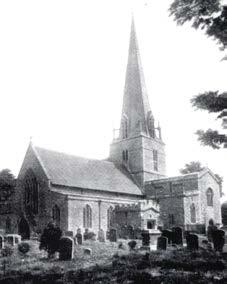

The well-known fourteenth-century Bampton reredos depicting Christ and the Twelve Apostles was placed in the present position during the Victorian restoration. It had been discovered in the north transept during the alterations, possibly having been hidden from the Puritan ‘image-breakers’ in the sixteenth or early seventeenth centuries.
10 11
4 Aspects
The oldest plans of Bampton show the three principal roads (or tracks!) radiating from a triangular market square, with a number of inter-connecting back lanes. As can be seen from many of the following photographs the views from the centre have changed little during the last 100 years and there remains a certain timelessness about the High Street, Broad Street and Bridge Street - most changes have been in the Market Square itself.

The Deanery is mostly of seventeenth-century construction but there is enough evidence to indicate that much of the original house was fourteenth-century. Parts of the house are probably considerably older, possibly twelfth or even eleventh-century, justifying the claim to be ‘the oldest house’ in Bampton’. In the thirteenth century the Deanery was the Bampton house of the Dean and Chapter of Exeter and resided in by a succession of clergy/farmers on their behalf.

The remains of Bampton Castle (now Ham Court Farm). The Castle was built during the early fourteenth century by Aymer de Valence, Earl of Pembroke and Lord of the Manor. By the end of the seventeenth century the Castle was in ruins except for the Western Gatehouse and part of the Curtain Wall (shown in the drawing) which were converted into a dwelling.

Until the mid-nineteenth-century the Manor House was known as the Deanery Manor House (as distinct from The Deanery used by the Dean and Chapter of Exeter) but the house became privately owned in 1860 and - progressively - has become known as Bampton Manor. It is probably seventeenth-century in origin with a late Georgian porch and east front. The original, medieval, Bampton Royal Manor (at Ham Court) became Bampton Castle when crenellated at the beginning of the fourteenth century.

Weald Manor was remodelled in 1730 (the earlier house was seventeenth-century) and in the middle of the nineteenth century was a school, known as St. Mary’s College.

Church Cottage, Church Street is one of the three ‘vernacular’ medieval houses thought to be still existing in Bampton; the others are the Cottage in Bell Lane (behind Market Square Garage) and probably the oldest with a classic ‘cruck’ frame construction and Knapps Farm House, in Bridge Street. All three date from the mid-fourteenth century to the mid-sixteenth century. They were originally timber-framed with open ‘halls’ and their roof timbers show thick soot deposits caused by smoke from open fires.
12 13

A very old photograph (c.1890) of the Town Hall before the ‘arches’ were enclosed - to the right, the grocer’s shop which later became the Romany lnn, next to the original shop established by the Dutton family in 1751.

George Dutton and young Billy Matthews (who eventually became the owner) outside the re-furbished shop soon after the turn of the century.

Market Square looking east towards the High Street. The shop on the right, London Cash Drapery Stores, ceased to trade after the First World War, becoming Brookings Drapers & Outfitters, then a garage, subsequently Barclays Bank and now Abbey Properties.

14 15
J.H. Brooking - successor to London Cash Drapery Stores.

John F.E.Wenman with his son Frederick outside Wenman’s (Bakers and Confectioners) in 1897. The shop was one of the properties demolished in 1920 to make way for the War Memorial.
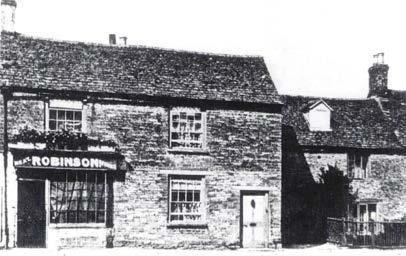
Charley Robinson’s butcher’s shop and to the right, the old Bell lnn (converted to the W.I. Hall in 1923 and becoming the Village Hall, in 1985). The shop site now houses the Flower Mill and, until recently, Health Matters.

Market Square looking west. The two shops on the right were occupied by Viner’s (a draper) and Joyner’s (a baker) which became Constable’s (also a baker’s) then a solicitor’s office and now a Chinese take-away!

Bridge Street looking east, showing the Elephant and Castle, then thatched, before a disastrous fire in 1950s. On the left the pavement before the present flood-protecting wall was built.
16 17
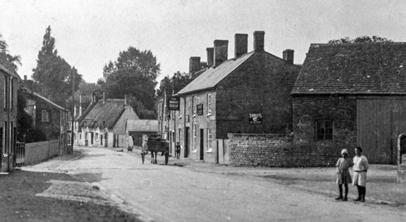



18 19
Bridge Street looking west. The Wheatsheaf public house - once called The Fish - is now the Post Office.
Percy Hughes with his son Leonard on his left, photographed at the beginning of the century at the doorway of his first butcher’s shop in Cheapside. In 1910 he moved to new premises adjoining The Horseshoe in Bridge Street. Percy was also landlord of the original Horseshoe, which burned down in 1914.
The George and Dragon is on the left; facing is a view of the old Lamb Inn (demolished to build the Market Square Garage). The single floor building, formerly Percy Hughes’s butcher’s shop, became a fish and chip shop in the 1950s.
Looking north-west from the Market Square. The thatched cottage (centre distance) was demolished in 1906 to make way for Eton Villas while the site of the pretty cottages (extreme right) is now occupied by Quebec Cottage and Melita.
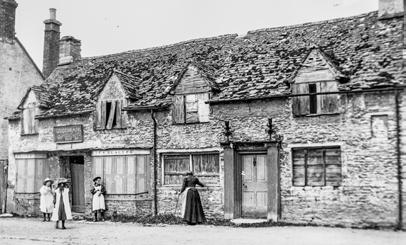
A closer view of the cottages one of which housed a small shop.

The shop on the left has seen many names on its frontage, including those of Holloways and then Beards followed by Martin’s - all printers. Subsequent owners and tenants included H.B. Jones ‘A General Store’, which appears in this photograph, Applegate & Son, and then Messrs Loverock, Norman, Slim, Gibbs, Harris’ and now the shop of Adrian Simmonds.
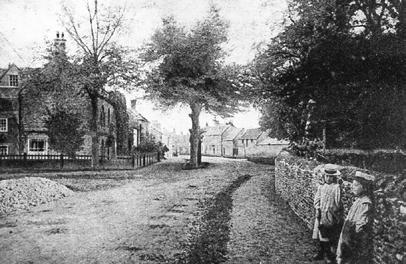
Another very old photograph of Broad Street looking south. The house to the left, The Elms, took its name from the trees which were cut down in 1890.

Broad Street, looking north, before the much publicised lime trees were planted. Records show that they were the gift of George Gerring, planted in 1902 at a cost of eight shillings each. Note the (now closed) gateway to the Manor House.
20 21




22 23
Much the same view but now with the trees in place. On the right is The Plough Inn (now No 7 Broad Street).
Another view of Broad Street in the 1920s, showing the young trees.
Broad Street, looking south.
Towards High Street, looking east. A late nineteenth-century view.

The Grange occupies the site of the mews mentioned in the 1812 Enclosure Award. The ‘Posting House’ at The George (later called The New Inn and now The Morris Clown) hired out horses and post-chaises, which were kept in those mews.

1901.

Street, looking east. How little this view has changed except for a cycle shop on the immediate left.

Mr Pembrey’s establishment, ‘Milliner and Mantle Match’ was also the Post Office at the time this photograph was taken. The two properties on the left are now Lesta House and Strawberry Cottage.
24 25
High Street, looking west, about
High


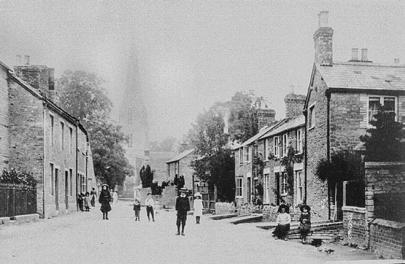
Church View was largely re-built towards the end of the 1800s and has changed little during the last 100 years.

26 27
Nearer the Market Square. Mr and Mrs Stephens - grocer and tea dealer, bacon and ham curer, beer and porter etc. became in due course the shop of Paul Bovington (see page 86).
Grayshott House to the left, with The Bell public house beyond the horse and trap.
New Road in the 1930s looking west, before any houses were built on the opposite, north side of the road.
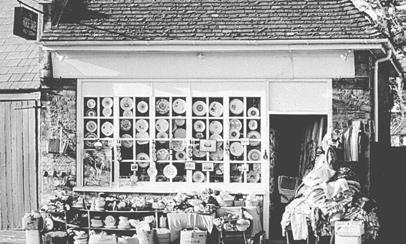

In 1968, less than thirty years ago, eighteen flats were to cost an average of only £2,600 each to build. Ten years before that the Witney Gazette of April 1958 had advertised for ‘good agricultural workers’ to work a ‘48 hour 5 day week at 3s 9d (l9p) per hour’.
5 The Horse Fair
The Fair was not always held on 25th August. When, in the thirteenth century, Henry Ill gave a Royal Grant for a weekly market to be held in Bampton, the same Grant also decreed that an annual fair might take place in Bampton ‘on the eve and on the day of the Assumption of Blessed Virgin Mary’ thus indicating that the fair day should be on the 14th and 15th August. In 1752, however, England adopted the new Gregorian calendar which required eleven days to be added to the old Julian Calendar and it seems probable that the dates upon which the Horse Fair was traditionally held (25th and 26th August) were the result of this change.
During the early years of this century, the Fair was nationally famous, drawing prospective buyers each August from as far afield as London and Liverpool. For several days before the Fair, horses would arrive by rail or road, and local farmers were said to charge sixpence a night for (anything up to 200) horses to ‘lodge’ in their fields. It was the big event of the year and everyone looked forward to it. Imagine if you will, hitching posts set up along Bridge Street and outside the Church, while windows were barricaded throughout our small town ... then just before six o’clock on the evening of 24th August a policeman would walk to the end of each main street and as the Church clock struck the hour, the show people, cheered on by watching crowds, would race with their caravans into the town to secure the best pitches in the Market Square.
The Fair did not start serious business until the next morning. Dealers and breeders would take their places in Bridge Street while the donkey and Welsh pony drovers set up shop outside the Church. This was Show Day when the best horses were sold by auction. The second day was known as Big Fair Day when horses, donkeys and ponies of every description were bought and sold.
A third day, Pleasure Fair Day, was held on 27th August each year. In 1899 the big attractions at the Pleasure Fair were Taylor’s Biograph (forerunner of the cinema), Madame Levita and a troop of performing crocodiles and serpents with, by 1900, Phillips’s ‘steam horses’ lit by electricity!
Between 1910 and 1930 the Horse Fair began to dwindle in importance almost entirely due to the advent of cars and lorries. Farmers no longer sought carthorses, tradesmen expressed less and less interest in cobs and mares for their delivery vehicles and demand for pit ponies and donkeys similarly fell away. From the the 1930s- and to the present day- the ‘fun-fair’ only remains.
28 29
Arthur Hill’s colourful ‘Antiques and Decorations’ shop next to The Horseshoe in Bridge Street where he was in business from 1939 until his retirement in 1984.




30 31
Bridge Street in 1904 showing The Horsehoe before it was re-built. Note the barricaded windows of the pub.
Outside The Wheatsheaf, Bridge Street.
Two visiting drovers are seen in the foreground.
Much trading took place around the Church.
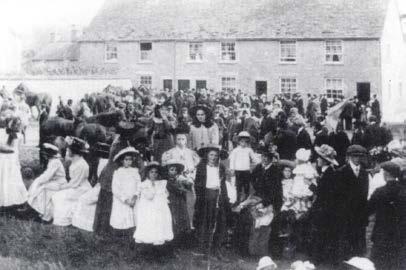
For their protection (from for example, runaway horses) women and children were required to stay within the safety of the churchyard walls and view the activities from there.



than its present-day successor.
32 33
Dealing in Church Close was mainly between breeders and buyers for the South Wales coal mines.
Adjacent to Kilmore House in Church Close.
‘Pleasure Fair Day’ attracted more patrons

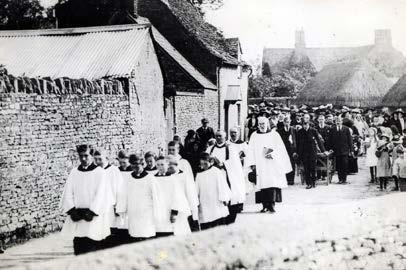
In 1912 the
6 Collett’s Car: The Bampton Voiturette
In 1888 the impressively named Oliver Onesipherous (or Omniferous) Collett opened a Watchmaker’s and jeweller’s business in Cheapside (now The Paper Shop) but one suspects that his real interest, which became evident later on, lay with the possibilities of motorised transport.
Before 1900 it is believed that he built a motor cycle and later made the first sidecar outfit in the district. His jeweller’s business soon took second place to motor repair and construction work, and he enlarged his premises, by taking over the adjoining Cromwell House.
Between 1901 and 1902 he built a small car which he named the Bampton Voiturette; in the photograph shown on page 36 the car is being admired by Roland Taunt, with 0.0. Collett, his wife and daughter in the driver’s and passengers’ seats. The car had cycle wheels and tiller steering but clearly did not succeed in becoming a commercial proposition! In 1908 its short life came to an end when it was dismantled.
0.0. Collett’s inventiveness did not, however, stop with the internal combustion engine, as the newspaper cutting shown here clearly demonstrates!

34 35
A view of the area on the north side of the Town Hall in August 1904.
twelve-year old son of a visiting shownman died in Bampton. At the funeral there was impressive support from the village. (The bier in the photograph is still kept in the Church.)

0.0. Collett’s 1907 certifcate from the C.T.C. authorising him as an ‘official repairer’.


‘0.0.’ upon his motor cycle at the side of what is now The Paper Shop. At the extreme right is a quadricycle - probably already obsolete when this 1908 photograph was taken.
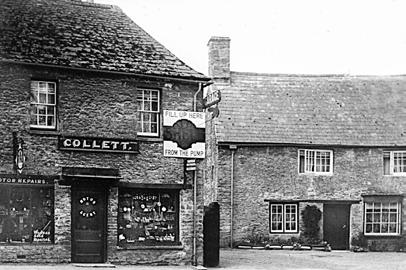
36 37
This is the ‘Bampton Voiturette’ at the junction of (the now) Bushey Row and New Road.
The watchmaker’s shop in Cheapside with Cromwell House in the background.

Before the shop became ‘double-fronted’ - note the ink outline of the proposed new window.
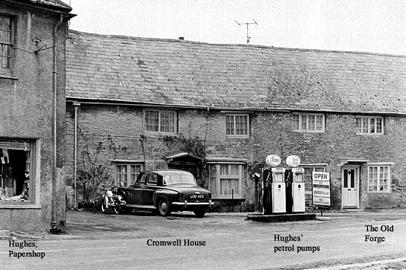
7
The First World War, 1914-18
From a population or about 1300 Bampton sent more than 250 young men to the First World War and casualties were very heavy. Fifty-one of’this number lost their lives and a further forty were wounded. Nine Bamptonians were decorated for valour, two men being awarded the Distinguished Conduct Medal and seven the Military Medal.
The extent of the carnage of the First World War is self-evident when compared to the figure of seven Bamptonians who lost their lives in the Second World War.
The group photograph shown here was taken in 1914 and of those named J. Dewe, Walter Lay and Jim Wells were fatal casualties (Jim Green and Jim Pryor were both wounded).
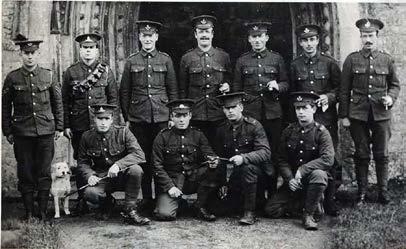
38 39
A mid-l960s photograph of Cromwell House and part of The Old Forge. The shop was Elsie Hughes’ woolshop with Hughes’ Garage and coach business to the rear.
Back Row, left to right: Jim White, J.Dewe, Bill Johnson, Walter Lay, Percy Shepherd, Jack Wells. Front row, left to right: Jim Green, Jim Wells, Jim Pryor, Jack Pryor.



8 The ‘Morris’
The true origins of this ancient English folk dance may never be known but many theories abound. Strong opinions are frequently held (and expressed!) with the ‘Morris’ being attributable perhaps to a pre-Christian pagan ritual (derived from a sword dance) or sympathetic magic to herald the birth of a new god or for some other fertility rite. Others say it may have been brought to England by gipsies or that its origins may lie in a Moorish dance from Spain (hence its name) having been brought to England in the reign of Edward Ill (1327-77).
There is common agreement however that the dance has been in being for close to 600 years and Bampton’s claim to have the longest unbroken record of performance is well-documented. This attribution appears over and over again in many books and articles and although other teams, from time to time, claim that they were the ‘originals’ (for example Abingdon, Headington, Chipping Camden) Bampton’s title seems unassailable. (In 1973 the boys of the Royal Ballet School ‘received instruction’ from the Morris Dancers of Bampton prior to an annual Folk Dance Festival at the AJbert Hall.)
Nevertheless it does seem that towards the end of the 1800s the popularity of Morris Dancing had begun to wane although a ‘vast revival’ is reported to have taken place during the early years of this century. The continuity at Bampton is said to have remained throughout this period but there may be some doubt about this when considered over a period of 600 years! It is perhaps appropriate to mention here the impact created by a young man who, although born in Weald, had moved with his family to London. In 1887, at the age of nineteen, he returned to Bampton. William Nathan Wells (becoming known universally as ‘Jinky’ or ‘Jingy’) quickly joined other members of his family in the Bampton team and began a career of what was to be no less than sixty years (as fiddler’ for most of this time) until his retirement in 1947. Sadly, Jinky Wells lost his sight before his death in 1953. His ‘impact’ however lives on today for he was, partly at least, responsible for the fact that today there are three teams of dancers in Bampton: ‘The Bampton Traditional Morris Dancers’, ‘The Traditional Bampton Morris Dancers’ and the third, formed in 1974, has the more succinct title of ‘The Bampton Morrismen’. When, in 1925 Jinky fell out with the team and started a ‘break-away group’, this proved a major catalyst for change but not before he had achieved national fame for his devotion to the ‘Morris’. A water-colour portrait still hangs at the headquarters of the English Folk Dance Society in London painted by E.M. Bateman, wife of the then vicar of Bampton.
AlI our Morris Groups perform upon the traditional day, Whit Monday, now the Spring Bank Holiday and competition between them is keen but friendly.
The history of many Bampton families is intertwined with the Morris. When researching the family names which appear in the eighteenth and nineteenth centuries one is struck by the fact that the surnames of Radband, Tanner and Wells appear some 200 years ago (all three of these families intermarried at one time or another) to be followed by Dewe, Dixey and others, all part of the Bampton ‘Morris’ history and names which are still to be seen in our electoral registers!
40 41
Left: Two young Bamptonians photographed prior to enlisting in the First World War. On the left is Walter Lay (sadly to be a fatality) with Bob Woodley. Right: Some of the large Tanner family showing, standing left to right: William, Lizzie, John; seated, left to right. ‘Buscot’ Tanner and Sophia
Bampton’s War Memorial was dedicated in September 1920. Over 1000 attended the ceremony. Two buglers from the Ox and Bucks Light Infantry sounded the Last Post after the unveiling by Major The Hon. E. Forester and addresses given by Col. Hammersley and Col. Rhys Williams, MP.


There are many familiar Bampton surnames in this 1897 photograph - nicknames were commonplace.
Left to right,
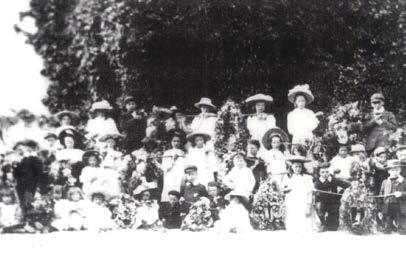
‘The Garlands’: each Whit Monday children prepared garlands of wild flowers made into two hoops with a doll in the centre and then paraded them around the village. Thanks to the efforts of Reg Pratley (then landlord of The Jubilee) this old custom was revived after the Second World War.

Dancing outside the Manor
in the
42 43
standing: Bob ‘Grank’ Dixey, ‘Jinky’ Wells, George ‘Nipper’ Dixey’, Joey Rouse, Dick Butler (fiddle), Charlie ‘Cocky’ Tanner. Left to right, seated: Phil Dewe, Harry ‘Sarah’ Radband, George ‘Chackler’ Wells, Thomas ‘Buscot’ Tanner
House
early 1900s. Left to right: Billy Wells (fiddler) supported by ‘Cocky’ Tanner and ‘Sarah’ Radband - the dancers being Bob Dixey and Jack Dewe; Perce, Jess, John and ‘Buscot’ Tanner; with David Edginton as the ‘fool’




44 45
A 1927 team in Lavender Square.
Left lo right ‘Jinky’ Wells, Bill Brown, Bill Dewe, Reg.Whitlock, Walter ‘Barlow’ Wells, Bert Whitlock, Jim Buckingham and Arnold Buckingham.
Emergency measures called for after a cloudburst on Whit Monday, 1932.
A fine view of the Church from the Deanery garden. ‘Jinky’ Wells.


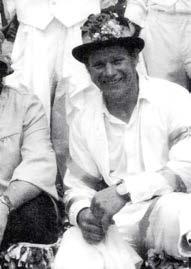
Top left: Arnold Woodley - ‘Squire’ of the Bampton Morris Dancers. Arnold, born in 1925, and who died early in 1995, was a Morris dancer for over fifty-six years and also a joint founder (with Jack Horne and Reg Absolum) of the Pumpkin Club, a Parish Councillor and an active member of the Horticulture Society.
Top right: Francis Shergold - ‘Squire’ of the Bampton Traditional Morris Dancers until his recent retirement.
Left: Alec Wixey - ‘Squire’ of the Bampton Morris Men after Arnold died in March 1995
9
‘In comes I’
The Mummers’ Play (or St. George’s Play) is generally thought to have evolved from the ‘sword dance’, a medieval folk custom symbolising the ‘death’ and ‘resurrection’ of the year. In different localities the plot often varies in detail but there is a surprising similarity throughout England in the ‘script’. All versions include the death of one or other of the characters following which the Doctor enters, boasts his skill and then revives the corpse. Thus the symbolism.
The play flourished until the mid-nineteenth century and it is claimed that although it has been performed in Bampton every year since 1946 (and remained extremely popular) it was also acted here long before the Second World War (given Bampton’s predisposition towards keeping alive its old customs). In 1946, a well-known Bamptonian, Ted Hunt, prompted by the then vicar, the Rev. Gregory Bateman, revived the annual play and while there was no written text, it was realised that the ‘words’ were remembered by older residents, thus continuing the practice whereby they have been passed on from generation to generation. Don Rouse who has been a member of the ‘company’ since 1948 and plays the Doctor, believes that the Bampton version is unique in that it is the only ‘two-act’ mummers’ play in the United Kingdom. Although fewer pubs are now visited than in the past there are still about sixteen separate performances (in different locations) each Christmas Eve and it remains an extremely popular custom.

Hunt, the driving force behind the 1946 revival, photographed here as ‘Old
46 47
Ted
Tom Tinker’.

Left: In the mid-1970s:
Left lo right, standing:
Bill Daniels (Father Christmas), Ted Hunt (Old Tom Tinker), Arnold Woodley (Robin Hood), Don Rouse (the Doctor).
Left to right,foreground:
Albert Woodley (Prussian King), Frank Purslow (Turkish Knight).
Below: A 1994 performance with (in front)
Frank Piercy (Old Tom Tinker) and Jason Blackwell (Robin Hood), Mark Booty (Father Christmas), Ken Adams (Prussian King), Don Rouse (Doctor), Matthew Green (Turkish Knight) in the back row. Other characters not portrayed in these photographs are ‘Little John’, Soldier Bold’, St George’ and Jack Finney.

10 The Great Shirt Race
It has been suggested that because Bampton was a particularly isolated community situated in the middle of a flat marshy plain, ‘largely covered in scrub’ before adequate roads and associated public transport became available, it was a centre for old local traditions and with a resulting keeness to preserve old customs. While the ‘Morris’ and the Mummers may qualify under this definition, the claim of the Original Great Shirt Race is much less certain for although its origins may well lie in the distant past (and there are those locally who will express firm views) it remains a fairly recent revival - if revival it is. If you will, you may select from one of the following:
i) a shirt race was first held in 1461 during the reign of Edward IV - although why is not suggested!
ii) During the reign of Ethelred the Unready (984 AD) he, the king, ‘chased the Burghers of Bampton in an unsuccessful attempt to clothe his nakedness’.
iii) An old custom revived in 1952 by John Quick and Paul Bovington, both founder members of the SPAJERS (Society for the Preservation of Ancient Junketing) and called the Original Great Shirt Race, as contestants were then required to wear long garments!.
Whatever the history it remains a most popular event held each Saturday before Whit Monday (the Spring Bank Holiday). Now, however, with a shortened course (no longer starting at Fisher’s Bridge) and with visits paid to only six pubs- at one time there were eleven - contestants are still required to change places in the ‘pram’ at each stop, after consuming the obligatory half pint of beer before racing on to the finish.
48 49




50 51
John Quick was a regular competitor, pictured here receiving a prize on behalf of his travelling companion and himself.
The Chairman of SPAJERS for many years (and in 1977 a relative youth) Frank Hudson is the ‘baby’ in mid-picture, being pushed by his cousin Jim Townsend.
Left: The ‘oldest competitors’ (1957 race) George Shergold, M.M. (aged 76) (father of Francis, Roy, Philip and Ruth [Wheeler] with Ted Hicks (aged 70).
Below: Sustenance at a change-over.
11 Events
Apart from the ‘Morris’, the Mummers, the Great Shirt Race and Annual Street Fair there were, and are, other annual and occasional shows and activities (among them the Pumpkin ‘Weigh-in’ and the Donkey Derby) thus maintaining Bampton’s reputation as a busy social centre.
Some of these events and activities have a long history and in the earlier part of this century village clubs were a blessing to the poor and under-privileged. Bampton was able to boast the Self-Help Club based at the The Lamb (demolished to extend the Market Square Garage) and the Victoria Club based at The Wheatsheaf (now the Post Office). The clubs - predecessors of state benefit - were ‘benevolent’ in that upon payment of a small weekly contribution, members could claim several shillings a week in times of illness. Whit Monday was ‘Club Day’; each club, sometimes headed by a band, marched in procession to the Church and took part in a combined service. After the service they returned to their respective clubs to partake of the Annual Dinner. It was not unknown for some Club Day celebrations to extend over three days!
Another popular day (held on the Sunday nearest the then August Bank Holiday) was known as ‘Hospital Sunday’, all the collections made that day being donated to the Radcliffe Infirmary. The prime movers for this annual event were the members of the ‘Ancient Order of Foresters’ which had its headquarters at The New lnn (now The Morris Clown). It was largely due to the Foresters that Bampton had its first brass band and one of the photographs was taken on 6th August 1900, when a new banner was unfurled for the first time. For the first year of its existence the band was known as The Foresters Brass Band, later changed to The Bampton Town Band. The conductor was Frederick Taunt (the church organist, see page 81) and it remained in existence until the outbreak of war in 1914. The following account from the Witney Gazelle of 18th May 1901 gives an impression of how villages were entertained at the beginning of this century:
On Saturday evening last this town was enlivened for the first time by the Foresters Band and they were well received by the public. They gave a short selection of music in the Market Square. On Tuesday last they met at their conductor’s residence in Broad Street and headed by their conductor, Mr. F.W. Taunt and Brother A.J. Bryant (Secretary or the Bush ‘Court’ of the Foresters) and Brother Beard (Treasurer) marched through the town to Market Square ... afterward proceeding to High Street to the residence of J Prall Esq. who has been a great supporter of the band and thence to the Court House (the New Inn) where a selection of popular music was listened to by a large and appreciative crowd.
(J. Prall was actually Dr. J.H. Prall, Medical Officer to the ‘Bush Court’.)
Today, clubs and societies abound in Bampton (see the Bampton Directory) and are almost too numerous to mention but the Society for the Preservation of Ancient Junketing- the SPAJERS- founded in 1953 as an ‘anti-telly’ society (but lost its way!) and the Bampton Pumpkin Club, founded in 1969, both deserve mention. Their similar objectives are raising money for Bampton’s OAPs at Christmas time.
The SPA.JERS organise the annual Great Shirt Race and The Donkey Derby, while the Pumpkin Club is responsible for the Street Fair, Dog Show and Great Pumpkin ‘Weigh-in’.
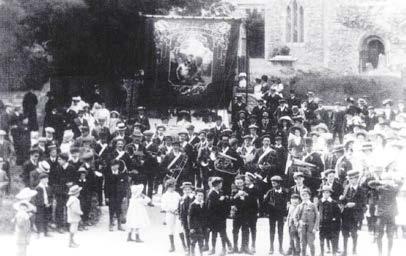
‘Hospital Sunday’ in 1905. The band of the Bush Court of the Foresters (with their banner, ‘Go Thou and Do Likewise’).
52 53

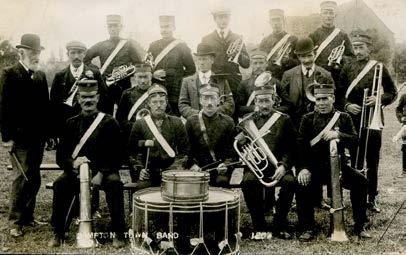


Outside the Church after the service.
54 55
The Foresters’ banner being processed past the Town Hall.
The Foresters Band, subsequently known as the Rampton Town Band (with their conductor, Frederick Taunt, extreme left) in their new finery of black uniforms with gold facings.
The Bampton Fire Brigade leading the procession from St. Mary’s Church on the occasion of King Edward VIl’s Memorial Service in 1910.

In 1906 Tory supporters hired a traction engine for ‘electioneering’ in and around Bampton. The photograph is taken outside The Talbot, with the landlord (Mr. Norman, with his hands in pockets) standing next to the chimney. A likeness of Joseph Chamberlain is held aloft.


Great excitement at Weald one summer’s day in 1914. Aeroplanes were then a rare sight and it is said that the pilot, the son of Admiral Blackburne of Weald Manor, was so intent upon impressing his Bampton girl-friend and her parents that he, as it were, lost control! (For the technically minded, it was a Grahame-White ‘Popular’ Type VII biplane.)

Mr. Tom Constable was thought to have been very displeased with the driving skills of his employee (at the junction of Church Street and Church Close).
56 57
Bampton Town Football Club, 1910-11.
Back row: Mark Kerry, George Batts, Harry Green Middle row: Fred Green, W.A.D. Morris, Bill Tanner Front row: Fred Fox, F. Robinson, Jim Pryor, Billy Walker, Jim Green.



Before combine-harvesters became commonplace the threshing machine was much in use but requiring, as the picture shows, rather more labour than that demanded by the ‘combine’.

58 59
In 1913 oxen were still being used at Ham Court (Bampton Castle) Farm.
Hay-making during the early years of the century.
The Elephant and Castle after the fire in October 1958.

The presentation ceremony in September 1969 when the Royal Corps of Signals, who manned the main army receiving station at Weald, marked the end of a thirty-year association with Bamplon, with the donation of the new bus shelter in Broad Street. Here Colonel Winn is seen shaking hands with Maurice Clack, then Chairman of the Parish Council.

12 The Railway Station
Bampton ‘s Railway Station was opened in 1873 and for reasons of economy (avoiding a loop) or, according to another source, because a local and powerful influence simply refused to have the railway crossing part of his ‘territory’, it was sited less than two miles from Bampton (almost alongside the main runway at RAF Brize Norton).
The railway was part of the East Gloucestershire Railway Company (E.G.R.) which ran from Fairford to Witney, there to link up with the Witney Railway Company’s line from Witney to Yarnton, near Oxford.
In 1890 both companies were acquired by the Great Western Railway in whose name they remained until nationalisation and finally the Beeching ‘axe’. In June 1962 the line was closed and among older residents there remains a great deal of nostalgia for ‘our railway’ even though a bus journey was required (originally a horse drawn vehicle) to reach the station! The track of the line, with its bridges here and there, is still clearly visible at certain spots although all traces or the station (re-named ‘Brize Norton and Bampton’ after the building of the airfield in 1937) have virtually disappeared.
In 1913 three young Bamptonians emigrated to Canada and the photograph below shows a crowd of well-wishers assembled to wish them farewell. A happy example of the community spirit at that time but later to end in tragedy for one of the three, Harry Green, a very popular young man who returned to England in 1914 and was killed in France in June 1916.
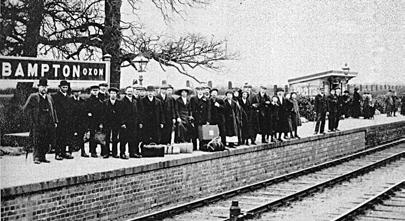
A Street Party in Glebelands on the occasion of the Royal Wedding in 1981. Among those in the photograph are Alan and Frances Cole, Basil and Elizabeth George, Pat Barratt, Marjorie Pollard, Maureen and Donald Seale, Jean Bassett and her family, Mr. and Mrs Walker, Audrey Taylor, Pat and Tony Clements and their family, and Joan and Elaine Curry. ‘Community Farewell’ to the 1913 emigrants.
60 61




62 63
Known to many as the ‘Fairford flyer’, the line ran from Witttey to Fairford via Bampton.
Bampton Station
The Sunday School Outing leaving Bampton Station in 1932 with Mr. Cecil Robinson in charge. Left to right, back row: Kathleen Glenister, Gladys Neal, Ken Wells, Ruth Oliver, Clive Craddock, Joan Whiting, Joyce Pinnock, Dorothy Green Left to right, front row: George Hunt, Chris Timms, Ivor Brooks. ‘
The platform at the (re-named) station.
13 The Fire Brigade
Bampton is justifiably proud of its Fire Brigade and during the early part of this century (when it had already been in existence for over 100 years) it was generally recognised to be the most efficient rural brigade in the whole of the South of England.
In 1884 a local builder, Cambria Williams, became Chief Officer and under his leadership the Brigade became Champions of the South Midlands District and in 1904 the National Champions at Crystal Palace. In 1919 Cambria (‘Cap’) Williams retired after forty-five years service to be succeeded by a member of the well-known Green family, Ted, another local builder whose relatives were closely associated with the Brigade for many years thereafter. Subsequent leaders of the Brigade include Arthur Beckley, who joined in 1946 and in 1960, became the Officer in Charge. In 1973 Arthur Beckley was awarded the BEM. The current leader (since 1978) is the well-known Tom Papworth, proprietor of ‘Emmies’.
The original hand-pulled fire engine was kept in the Church and the Church Bells were rung for an alarm. Subsequently a ‘more modern’ fire engine was kept in the Town Hall (see page 6) until 1971, when the new Fire Station was opened in New Road.

It is difficult to overstate the importance and enormous civic pride which Bampton atttached to its Fire Brigade in the early 1900s: These extracts from the Witney Gazette of Saturday 30th July 1904 speak for themselves.
‘Rules and Charges’ for the Bampton Fire Brigade .

64 65


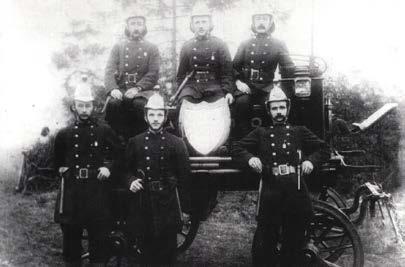

66 67
A photograph taken in 1901: note the black arm-bands worn to mark the death of Queen Victoria. Back row, left to right: Ossie Williams, Ted Green, Tom King, Jack Cripps. Front row, left to right: H. Eustace, Dick Rose, Cambria Williams, George Cripps. Every man sports a moustache!
A 1905 photograph.
Standing, left to right: Ted Green, Isaac Widdow, Jim Green, Tom King, Tom Constable, George Townsend, Fred Fox. Seated, left to right: Cambria Williams, Dick Rose.
Helmeted and in full ‘dress uniform’.
Three senior officers in the Bampton Brigade.
Left to right: Ted Green (who succeeded Cambria Williams as Chief Officer in 1919), Cambria Williams and Dick Rose.

At a competition in Brighton (all those competing used Brighton’s equipment): George Townsend, shirt-sleeved on the right, was the landlord of The Eagle public house, and who, it is said, ‘shot the mad bear in 1901’ but that would perhaps be another story!
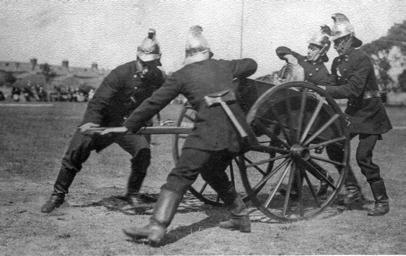
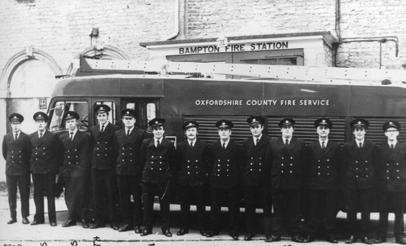
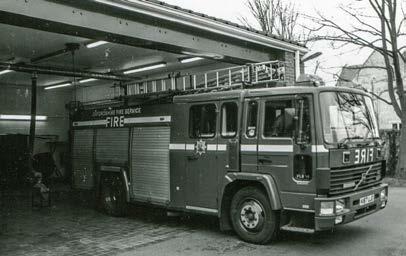
68 69
An action photograph taken at a competition held in Wantage in the early 1920s.
A photograph taken in 1971, immediately before the move to the new fire station in June of that year.
Left to right: Fred Roberts, Ken Keates, Tim Tomlins, Tom Papworth, ?, H. Green, C. Timms, A. Beckley, R. Green, M. Hirons, R. Holtom, B. Kew, P. Nicholson.
Our modern appliance at the New Road Fire Station.
14 Schools
At the beginning of the century there were four schools in Bampton: the Old Grammar School (the Library since 1964); the National School in Church View (now the Youth Centre); a Girls’ High School (at Ampney Lodge at the corner of Aston Road and in the High Street) and Bampton Commercial College (at Wheelgate House in the High Street). But there were others which existed from time to time in some of the larger houses. Prospect House, for example, The Elms and, in the High Street, ‘Miss Dutton’s School for Young Ladies’.
The National School was originally opened at the site of Box House in the Market Square in 1812 but education generally in Bampton was badly neglected until the mid-nineteenth century, when classes were re-started in the Old Grammar School. In 1873 the new National School was opened in Church View and became Bampton ‘s principal educational establishment when, in 1899, the Old Grammar School was closed by the Charity Commissioners.
A number of the private schools failed, but that run by a local man, Alfie Bryant (who had ‘fingers’ in many ‘pies’) succeeded for some time. Alfie Bryant was ‘into’ everything. Besides running the school he was a newsagent, an insurance agent and secretary of numerous local societies. The photograph of three young emigrants (see page 61) shows Alfie Bryant in the centre of the group! The school, at Wheelgate House (which later became the Post Office) was known to most as ‘Alfie Bryant’s school’, but more formally as the Commercial College. Some alleged that its success was due to the straw ‘boaters’ required to be worn by its pupils! Lloyd Hughes-Owens writes, ‘A third-rate school’!
In 1927 the National School became the ‘Bampton Senior School’ when children from Aston, Clanfield, Black Bourton and Carterton were added to the classes and, to accommodate the extra numbers, a wooden building containing two classrooms was built between 1928 and 1929. Later two large army huts were rented to house a workshop and a domestic science room, which were meant to be temporary but remained in use until the school closed. By 1954 there were 260 pupils at Church View.
Six years later, in 1960, Bampton’s new school was opened in Bowling Green Close and all children under the age of eleven were transferred there. Bampton Senior School then became Bampton Secondary School but it was not to survive under the then government’s education policy and the decision to close it was made in 1965. In 1983 the Youth Centre was opened and this probably saved the old school from becoming a ruin.
Bampton’s new primary school was one of the first open-plan primary schools which were built in the country during the l960s. It became much visited and written about nationally. Attracting visitors from all over the world it was a tribute to the skill and adaptability of the staff, who had to change the way they taught almost overnight.
Today the Primary School has about 170 pupils aged from four to eleven with a staff which includes: a headteacher, six teachers and four Learning Support Assistants.
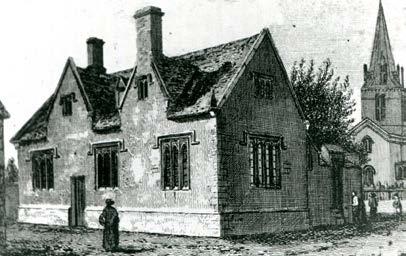
In 1635 a bequest of £300 from Robert Vaisey, a retired wool merchant from Chimney Manor, led to the founding of the Grammar School which opened eventually in 1653. The school had a rather unsuccessful history which led to its closure in 1899. Now the Bampton Library, its appearance has hardly changed in 350 years.

71
70
The building being re-roofed in 1910. The three figures on the roofs are Arthur Plaster,John Tanner and Alfred Collett.


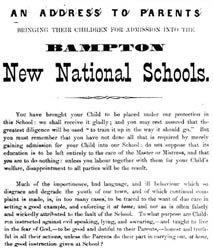
A notice received by all parents.
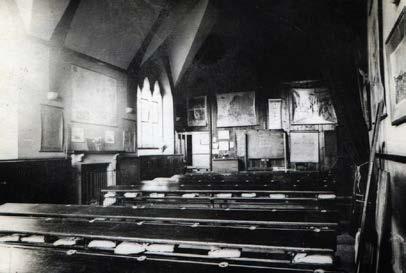
The ‘big room’ at the school before a partition was erected and class sizes reduced. It was not unusual to see classes of fifty or sixty pupils in the early years.
72 73
Pupils outside Bampton Commercial College (the ‘Alfie Bryant School’) which closed at the outbreak of the First World War.
The National School, in Church View, which opened on 29thJuly 1873.


The school’s primitive lavatories. (More recent residents might be surprised to learn that there was no mains drainage in Bampton until the mid-1950s!)

school photograph taken in 1902. For the camera the girls were required to wear freshly laundered pinafores and boys,

A photograph taken immediately after the end of the Frrst World War. The boy on the extreme left of the front row (Ben Tanner) became school caretaker for over twenty years and the young girl second from the left in the second row (Lucy Slatter - nee Fox) was in charge of the school kitchen for many years.
74 75
The ‘infants’ room.
A
collars and ties with their Sunday suits.

A dilapidated cow-shed in the paddock to the north of the school was converted into a very useful building by W.J. Young, the woodwork master and some fourth-year boys.
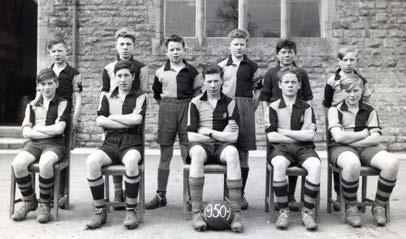
Many thought this was the best football team the school ever had.
Standing, left to right Roy Farmer, Terence Sweetingham, John Hayward, Brian Comley, Albert Gresswell, John McCrudden. Seated left to right Gordon Barnett, Alan Govier, John Cummings, Raymond Kingston, Brian Barnett.

Thought by the Headmaster to be the beginnjng of the school’s ‘golden age in hockey’! They are seen here wearing new kit of ‘old-gold’ shfrts and blue shorts. Bach row: Doreen Ellis, Enid Owen, Pat Keen, Primrose Mansfield, Sylvia Dewe, Mary Robinson, Jennjfer Barton. Front row: Shirley Mansfield, Shirley Bishop, Joan Whitlock (Capt.), Eileen Sweetingham, Evelyn Brown.

A 1951 group of thlrd-year girls. Back Row, left to right: Sheila Fitchet, Shirley East, June Crapper, Joan Harrison, Evelyn Brown, Doreen Ellis, Pamela Pizzie. Middle row, left to right: Betty Long, Yvonne Timms, Hazel Sutton, Primrose Mansfield, Doris Radband, Rosemary
76 77
Day. Front row, left to right: Patsy Keen, Maureen Barron, Mary Robinson, Enid Owen, Shirley Bishop.

The new Primary School in Bowling Green Close.

And the ‘Log’ started by the Headmaster on Day One!


Opposite: ‘Old White’ (sometime gardener at The Grange) in his ‘Sunday-Best’ smock and scarlet neckerchief. Some Bampton women were well-known for their skills in ‘smocking’, creating intricate and decorative stitching.
78 79
Above: William and Julia Daniels, outside their saddler’s premises in Queen Street about 1880 (the grandparents of Freda Bradley).
15 People
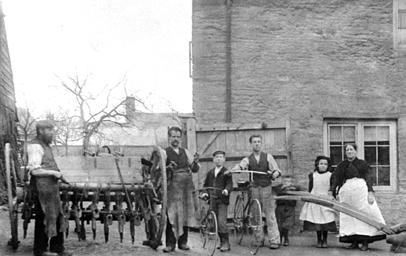
The Cripps Family, the other Bampton blacksmiths, outside Cromwell House, premises which were taken over by 0. 0. Collett in 1908 following the death of Mr. Cripps senior.

The blacksmith’s business, then owned by Messrs Townsend and Wheeler moved next door to a property still known as the Old Forge. The two houses, now, in 1996, separately owned, were originally one timber-framed sixteenth-century building.

Daniel Gibbard, also a Bampton blacksmith al the turn of the century. His premises were al Folly View in Market Square (now rebuilt in red brick). He died in 1911, aged eighty.
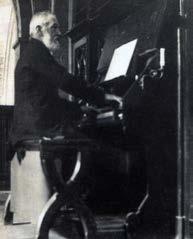

Left: Frederick Taunt of Waterloo House is described in Kelly’s Directory of 1911 as a ‘tax collector’ but it was as a musician that he was much better known. In addition to being the conductor of the Bampton Town Band and the Bampton String Orchestra he was also organist at St. Mary’s for fifty years until his death in 1915 (to be succeeded by his daughter, Cecilia, who remained organist for the next forty years!).
Right: In 1910 May Morris, daughter of William Morris, the fan1ous nineteenth-century writer, artist and designer who lived at Kelmscott Manor, standing at the gale of the school in Church View, inviting support for Votes for Women.
80 81


Left: Percy Sheppard (father of Edie Quick) was the stoker at the Gasworks for over forty years and - in his ‘spare time’ - a small holder. Right: Another well-known figure - P. 0. Money - a shoemaker and leather worker who came to Bampton in 1931, acquiring a business in Bridge Street. Percy Money retired in 1967 and died in 1990. His widow, son Richard and daughter Madeline (wife of Gerald Read) still live in Bampton.

Albert Chandler, at eighty-three, at his saddler’s premises in Market Square where he had his business and workshop for over fifty years. It is said that he did much work for London clients (receiving orders through the post) and that at one time he had 900 horses ‘on his books’. He also served as Clerk to the Parish Council.

In 1934 Lucy Martin provided the upstairs room of The Eagle for the use of the Roman Catholic Church. There was seating for about thirty and a confessional screen at the rear. This photograph was taken in 1960. Later, services were held in the Town Hall Gallery, then Bampton Library and some twenty years ago, in one of the first instances where the Roman Catholics shared a church building with the Anglicans, it was agreed that Mass would take place each week at St. Mary’s Parish Church.


Left: This is ‘Emmie’ (Papworth) when she was a post lady in the early 1960s. Her name survives at the newsagents in Bridge Street, where her son, Tom, now has the business. Emmie (nee Bishop) was a Land Girl during the Second World War and in 1966 took over the shop, which had been in the Bishop family since the 1930s. She died in 1987. Right: Marjorie Pollard, who lived at The Deanery, was an international cricket and hockey player, journalist and broadcaster. A much respected figure, always willing to help others in many different ways, often anonymously.
82 83

Emmie (with her sister Edie Foreshew) as many will remember her.
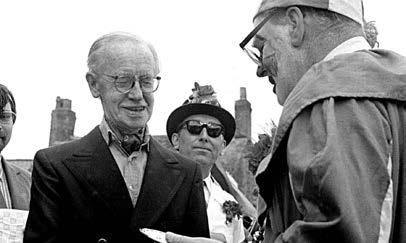
J. L. Hughes-Owens (left) with Arnold Woodley and ‘Son’ Townsend at a Whit Monday Morris performance. Lloyd Hughes-Owens came to Bampton from Somerset at the end of the Second World War and was Headmaster of the Bampton School for twenty-one years until his retirement in July 1965. He acquired a considerable knowledge of our local history during those years which led, eventually to his book, The Bampton We Have Lost


84 85
Seven ex-Presidents of the Bampton Women’s Institute meet at the occasion of the Women’s Institute Diamond Jubilee in 1981. Left to right: Kate Wylje, Joyce Lee, ‘Biddy’ Gould, Jean Howell, Frances Henly, Rose Gerring, Frances Cole
A British Legion Party in the 1950s. Back row, left to right: Phyllis Colville, Millie Birch, Edie Foreshew, Mabel Dixon, Kit Tanner, Lucy Shergold, Elsie Ellis, Nellie Brooks, Beatrice Horne, Ada Tanner, Alice Puttock Front row, left to right: Liz Tanne1·. Kath Tanner, Joan Keyte, Rachel Foreshew, ‘Father Christmas’, Lady Carr, Michael Brooks, Carrie Scoble, Clara Drinkwater, Kitty Jackson, Ann Jackson.

In 1969 the Bampton Weight-Lifting Club was host to the Bristol Weight-Lifting Club, which resulted in a Bampton victory - in spite of Bristol fielding the International and Olympic weightlifter, Precious Mackenzie. The photograph shows,.from left to right, Sidney Pickard (Club Chairman) Hilda Pickard, Precious Mackenzie and Don Rouse (Secretary, and Area Lightweight/Middleweight and Light Heavyweight Champion at various dates in the 1960s).

Paul Bovington, with his dog ‘Crackers’, photographed in July 1960. He was joint founder, with John Quick, of the SPAJERS. Paul’s voice was always very audible at the annual Great Shirt Race (see page 49).

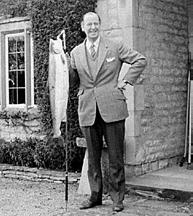
Left:John Quick (1915-89) well-Ioved, joint-founder of the SPAJERS (see page 52) and Secretary of Bampton British Legion for thirty years. A Bampton ‘character’ who has been, and still is, much missed. Right: Dr. John Bullen, a keen fisherman as well as the very popular senior partner of our medical practice for many years. In 1948 he joined Dr. McCartney to form the first Bampton medical partnership. Now forty years later, the practice has become a large and comprehensive medical unit and in 1996, including the doctors, is staffed by no less than twenty-seven people.

Prior to the retirement of Dr. Alan Cole, this 1989 photograph shows ‘the team’ at Bampton surgery at the site of the proposed new surgery. Back Row, left to right: Dr. Ronald Mackenzie, Dr. Patricia Russell, Mary Bain, Dr. Robert Landray, Eileen Lloyd, Wendy Ellison, Dr. Alan Cole, Frances Cole, Renee Barnard, Stephanie Venn, Liz Costar, Carole Perry, Dr. Matthew Perry. Front, left to right: Jenny Gauntlett, Mavis Newing, Jane Hodgkison, Pat Wellington.
86 87

To Susan Phillips of Haytor, Lavender Square, goes the credit for not only devising the first Bampton Directory (and arranging for its free distribution to every household) but the idea of converting her typewritten reports of the deliberations of the Parish Council into a fully-fledged thrice-yearly newspaper, The Bampton Beam, which for the last ten years has also been delivered ‘free’ to each house in the village. Vol. l.(No.l) in March 1986 had four pages: Vol 10 (No 3) in December 1995 had twenty. Determined and resourceful, she is someone to whom all Bamptonians owe a considerable debt of gratitude for her unique contribution to our community spirit. After ten years as founder/editor Susan has now handed the reins to Fenella Gray, a daughter of John and Edie Quick.
Dor Thomson has lived in Bampton since 1949 when she and Kate Wylie moved to Beam Cottage (‘The Beam’) and where they were to live for the next thirty years. After wartime work in an aircraft factory Dor became a small-holder while she and Kate were also foster parents to two young Londoners. A County Councillor for sixteen years, a member of the Parish Council for over twenty, it is nevertheless in the field of education that Dor has made a major contribution to Oxfordshire. In addition to Bampton, where she was Chairman of the Governors of Bampton Primary School (and of which she is now an Honorary Governor) she was also a member of Oxfordshire’s Education Committee for fifteen years, and particularly concerned with primary and special schools. She and Kate now live in Cheyne Lane.

Acknowledgements
We wish to record our considerable appreciation for the work of Roy Barratt who has produced all the photographic reproductions which appear in these pages. He has been generous and unstinting in the giving of his time and skill: similarly we owe a great deal to Annabel Jones who guided us through the intricacies of costing, printing and publishing.
To Bampton Parish Council we are grateful for their financial support towards the cost of production and their blessing upon the whole enterprise. Special thanks must go to Jonathan Phillips, our District Councillor, who, in his private capacity agreed to underwrite the entire project thus giving us the necessary confidence to proceed towards publication. He also undertook the marketing of the book. Help and advice has been provided willingly by John Ackerman, Dr John Blair, Matthew Green, Frank Hudson, Roger Howard (who thought of the idea in the first place) and Annabelle Newman (who suggested the title). Abbey Properties has also been happy for us to make free use of their photocopier.
Finally, to all those Bamptonians and others who have provided us with the ‘raw material’ - the photographs - we say ‘thank you’. We are especially grateful to Rona Hughes-Owens who lent us a considerable number of these from Lloyd Hughes-Owens’s collection. We are also indebted to her for permission to use extracts from The Bampton We Have Lost. The Oxford Times and the Witney Gazette have allowed us to reproduce some pictures and cuttings: similar permission has been provided by the Oxfordshire Photographic Archive of O.C.C. The Family Tree on page 42 has been reprinted with the permission of the author, Keith Chandler from Morris Dancing at Bampton Until 1914. From personal and private collections, contributors of photographs include the following:
Roy Barratt
Freda Bradley
Rosemary Colvile
Edie Foreshew
Arthur Hill
Kitty Jackson
Hilda Kent
Syd Lusted
Tom Papworth
Edie Quick
Dor Thomson
Mary Williams
Arthur Beckley
John Bullen
Terry Crowley
Rose Gerring
Margaret Howse
Gertie Jordan
Betty Lock
Richard Money
David Pimm
Don Rouse
Janet Westman
We offer most sincere apologies to anyone whose name has been inadvertently omitted.
John Parrish
Janet Newman
88 89


Images of Bampton - a visual history of an Oxfordshire market town since the beginning of the 20th century, reflecting national and local events during that time.
An important Anglo-Saxon settlement, Bampton is mentioned in Domesday and famous for its connection with Morris dancing.
Images of Bampton provides a unique insight into the town’s daily life and changing character since the early days of photography.
Recommended price £10.00
ISBN O 9529562 O 9



































































































































































